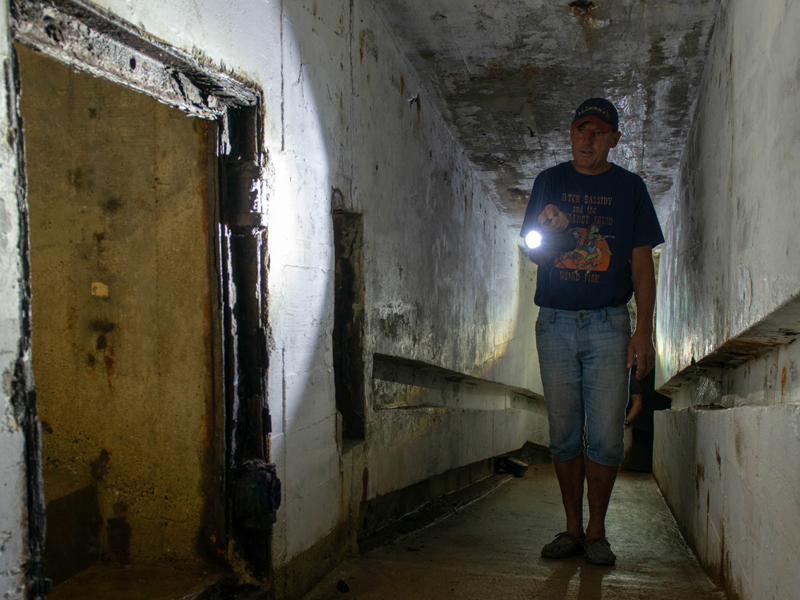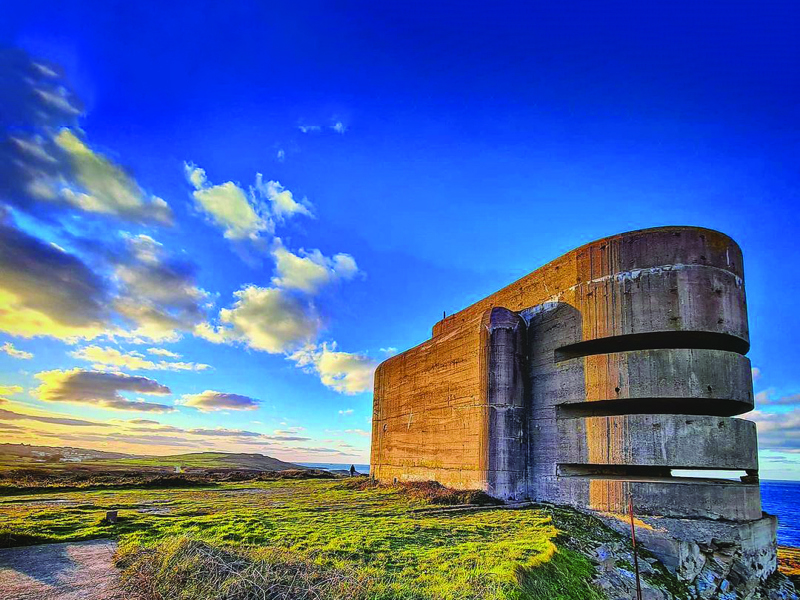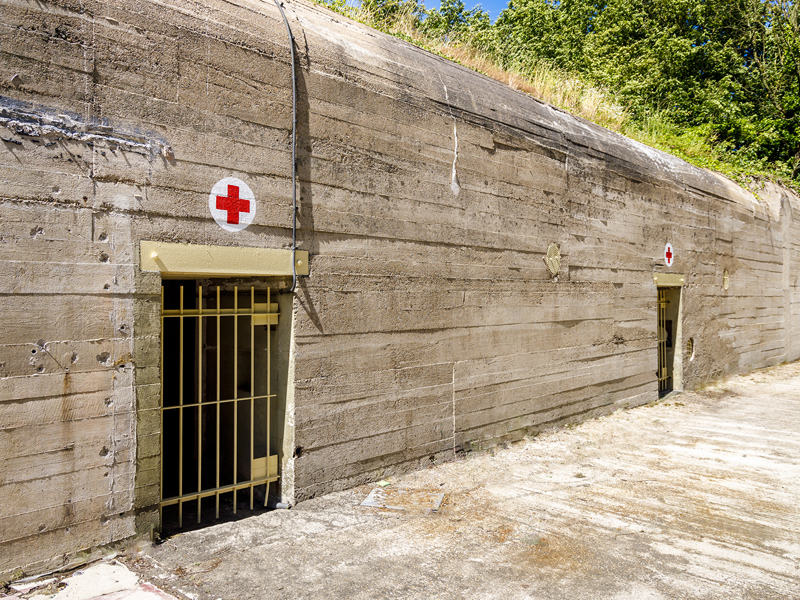Alderney's WWII Story
The Channel Islands were the only part of the British Isles to fall into enemy hands when they were occupied by German forces between 1940 and 1945.
Unlike the other Channel Islands, almost all of Alderney’s population chose to evacuate the island. On 23 June 1940 at 6am, St. Anne’s Church bells rang to notify the 1500 residents that six Royal Navy ships were approaching Braye Harbour to take them to the mainland. They had only hours to gather their belongings and assemble, with no way of knowing whether they would ever see their island again.
The Germans arrived, and for the first year of the occupation Alderney was mainly used as the ‘larder to the Channel islands’ growing food for the German troops and other Channel Islands. Light artillery and anti-aircraft positions were set up, along with the strengthening of the Victorian forts. But in 1941 Hitler ordered the conversion of Alderney into an impregnable fortress as part of his ‘Atlantic Wall’.
Thousands of slave workers, from the Nazi-occupied countries of Europe, were shipped to the island to build hundreds of bunkers, trenches, anti-tank walls and tunnel complexes. They were housed in four camps. Sadly deaths among the workers from starvation, disease, overwork and brutal treatment, were a regular occurrence.
The Germans surrendered Alderney on 16 May 1945, seven days after the liberation of Guernsey and Jersey. However, the people of Alderney could not immediately return due to the huge clean-up operation needed, including the removal of over 30,000 landmines. It was not until 15 December 1945 that the islanders began to return to their devastated island.
23 June 1940: The Evacuation

Evacuees have a last glimpse of home: Courtesy of Neil MacDonald
At 6am St Anne’s church bells started to ring to let everyone know that six small merchant ships with a Royal Navy escort are approaching Braye Harbour. With the exception of a handful of islanders who decide to stay, most headed to the harbour to board the ships having no way of knowing if they would ever see their island home again.
On arrival at Weymouth, the evacuees took trains to their new temporary homes scattered all over England and Scotland; many would end up in the Midlands, Birmingham and Glasgow.

German troops parade in Marais Square shortly after the occupation. Courtesy of the Alderney Society
July 1940: The Germans Arrive
On 2 July 1940 a small German force arrived to occupy Alderney. Units of the army (Heer), air force (Luftwaffe) and navy (Kriegsmarine) followed, setting up light artillery and anti-aircraft (Flak) positions, with basic fieldworks and strengthening of the Victorian forts. The airfield was deemed to be of no tactical value and was obstructed for the duration of the war. All communication throughout the war was done by sea.

Oberst Schumacher inspects the accounts office of the German Field Command at Lloyd's Bank, Victoria Street.

Target practice by German soldiers on Platte Saline.

German Naval Personnel Drag The New Guns Into Position In Fort Albert. 1941

One Of The Guns At Battery Annes On The Giffoine. 1941

The ‘German Jetty’ Built In 1942 With Its Three Cranes. It Was Demolished In 1978.
Following Hitler's directive of October 1941, in which the Channel Islands were to be transformed into an ‘impregnable fortress’, the Organisation Todt (OT), who were responsible for the building programme, used foreign forced and slave labour from many of the Nazi-occupied countries of Europe to construct the fortifications. Four camps were built in Alderney to house the thousands of workers brought to the island - Russians, Ukrainians, Poles, Frenchmen and Spaniards, including Jews. Each camp was named after a German North Sea island.

A View of Norderney Forced Labour Camp at Saye. Courtesy of Colin Partridge

Slave workers with an Organisation Todt overseer behind Longis Villas, Longis Road. © Alderney at War, Brian Bonnard
The forced labourers worked 12 hours a day with a short break for a watery soup at midday, seven days a week, with half a day off on one Sunday in the month. Deaths from starvation and disease were the direct result of this treatment, added to which the labourers were subjected to arbitrary beatings and summary execution.
1943

Sylt camp looking from the SS compound towards the gates. Courtesy of the Alderney Society
In March 1943 the SS (Schutzstaffel) Construction Brigade I arrived in Alderney in two ships with around 940 prisoners from the Sachsenhausen concentration camp near Berlin. They took over the Lager Sylt camp from the OT after enlarging it. At this date, it is estimated that there were over 3,000 foreign workers in Alderney, not including those brought by the SS. The extra prisoners at Lager Sylt provided additional labour for the construction of the permanent defences as the building programme on the island reached its peak in April 1943, but many died as a result of the brutal SS regime of starvation, beatings and murder.
The ‘Russian Cemetery’

Courtesy of RAF Museum
Deaths among the prisoners from starvation, disease, overwork and brutal treatment, were a regular occurrence. The peak occurred between October and December 1942. The first burials, totalling some 66 workers, including two French women, took place in the churchyard of St. Anne.
Demand for a larger burial ground soon led to the opening of the ‘Russian Cemetery’ at Longis. Sadly, the surviving death and burial certificates, coupled with confusion over the timely marking of individual burials, have led to continuing speculation over the number of deaths.
1945
The Run Up to the Surrender of Alderney
On 1st May 1945 the news was announced that Hitler had died.
8th May was Victory in Europe (or VE) Day, where the German Forces unconditionally surrendered in Europe. On this day Winston Churchill gave a speech on the radio when he said,• ... and our dear Channel Islands are also to be freed today·.
On the same day, Brigadier Snow and his staff (known as The British Task Force 135) set sail from Plymouth to Guernsey on the HMS Bulldog. At 7.14am, 9th May 1945 the German Forces signed the Guernsey surrender agreement onboard HMS Bulldog, anchored off St Peter Port.
There are reports of big crowds, cheering, singing, crying and much happiness.
Brigadier Snow sailed from St Peter Port to Jersey, where the surrender was signed there at 10am. Guernsey and Jersey share the same Liberation Day but there were not enough troops to liberate Sark until 10th May. The Dame of Sark was put in temporary charge of the German garrison in the meantime. During her week in charge of the garrison, she ordered the 275 Germans to start tidying up the island.
16 May 1945: The Surrender of Alderney
A week after the Liberation of Guernsey, Brigadier Snow and units of Task Force 135 arrive in Alderney to accept the surrender of the German Island Commandant, Oberst Schwalm.

The surrender is signed in an officers’ mess, the now pink house at the bottom of Braye Hill.

The majority of German troops, now prisoners of war, were transferred to camps in England, with some 500 being retained to help clear up the island. The main German POW camp is at Fort Albert.
May-December 1945
Over the following seven months, the British Army, assisted by German prisoners of war, worked to prepare Alderney for the return of its civilian population. Around 300 houses were made habitable.

Many homes had been stripped of furniture and fittings by the occupying forces, and during the final winter of the Occupation, roof and floor timbers were used for firewood. Tons of military equipment were removed from the island and dumped at sea, while more than 30,000 mines were cleared and destroyed.
Tragically, one member of the British force, Sapper George Onions, was killed while supervising the mine-clearing operation carried out by German troops. He is buried in St Anne’s churchyard.
15 December 1945
Homecoming Day - the first group of about 100 islanders, including children, finally return to Alderney several months after VE Day.
As the ship draws alongside the ‘German Jetty’ in Braye Harbour, they are welcomed by the newly appointed Lieutenant Governor and a British Guard of Honour.

The island was a very different place to the one that they had left behind over five years ago.






